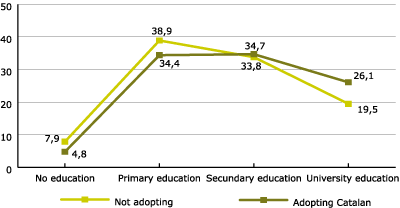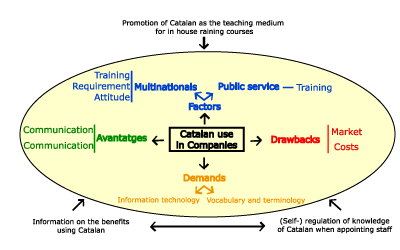
| Language policy in multinational and public service companies in Catalonia, by Joan Solé Camardons, Jonatan Castaño and Agustí Díaz | ||||
| CONTINUA |
For that reason it is important to regulate or foster policies of promotion of Catalan given that, as we saw earlier, the language is labouring under a double difficulty. On the one hand it lacks a nation state which would promote national culture and this function is necessarily left to regional and local government. This devolution is desirable, under the subsidiary principle, as long as the state also lends a hand. 6.2 Guidelines for language policy in the companies Training and language In both types of company we have seen that the variable that most correlates with the use of Catalan is the percentage of internal training staff training courses carried out in Catalan, (IUCE=28.7 in the case of the big companies and ICUC= 37.3 in the public service companies if less than half the courses are carried out in Catalan, and IUCE=51.1 in the big companies and 66.5 in the public service companies if more than half are carried out in Catalan). But this variable is as explanatory of use as use is explanatory of the fact of the percentage of courses, leading to a circle with positive feedback, so that if one of the two is increased the other will increase also, and this will increase the first in turn, and so on progressively. This fact is explained by two phenomena. Firstly, in the qualitative study of use of Catalan in big companies it was found that these companies adapt the language of the courses to the language of workers, and thus it follows that with greater use of Catalan there will be a greater proportion of in-house training courses in Catalan. But this phenomenon works in the opposite direction also, the proportion of courses of this type in Catalan will help to normalise this language among the workers and thus have a positive impact on its use. The fact that training in Catalan affects use is also shown in a more generalised way, in the data from the Enquesta d’Usos Lingüístics del Català (EULC) (Survey of patterns of Catalan language use) where we see that mother tongue Spanish speakers who adopt Catalan as their usual language are more highly educated than those who do not do this, and thus we can see that the fact of having received their education in Catalan reinforces use in all settings. Figure 10. The adopting of Catalan as usual language
In accordance with the findings discussed to this point, we propose three lines of action or aspects of such for a language policy in multinational and public service companies, which we sum up as follows: 1. Promotion of the mechanisms that guarantee that internal training programmes will be mostly in Catalan . 2. Regulation or self-regulation of knowledge of Catalan as a precondition for being hired by the company. 3. Public information directed at companies on the advantages of using Catalan. In terms of training, we see that if we want to develop a language policy for companies, or at least for the two types of company analysed here, it might be a worthwhile to promote the idea that the language used as teaching medium in the in-house training programmes should be in Catalan since these play a crucial role in normalisation of the language in the company. In terms of hiring new staff: in the big companies too it can be important to intervene in this process, building in knowledge of Catalan as a requirement, at least in key points like those where there is contact with the outside world, whether other companies or the end consumer. It would also be good to inform about the benefits in communication with clients, customers and consumers that accrue from increasing or improving the use and quality of communication in Catalan. And to inform people also that the use of Catalan does not mean losses, and does not involve greater risks than not doing so. The Secretariat for Language Policy is publishing a site about guidelines on multilingualism in company webs. Below is a table summarising the basic ideas emerging here.
To set about tidying up these ideas a conceptual map has been drawn up with use of Catalan in companies as the central element, flanked at the sides by elements that explain this use, the main advantages and drawbacks that companies perceive this use to have, and the main demand for language services originated by these companies. We have also described the three main vectors of the public policies that need to be implemented to act on these factors and thus indirectly on the use of Catalan in the multinational and public service companies. Diagram 3. Factors, demands, advantages
Alarcón, A. Economía, Política e Idiomas. Intercambio lingüístico y sus efectos sobre la eficiencia y la distribución, Consejo Económico y Social, Colección Estudios no. 158, 2004. Enquesta sobre Usos Lingüístics a Institucions Públiques (EULIP), Generalitat de Catalunya, Department of the Presidency, Language Policy Secretariat, 2004. Estadística d’Usos Lingüístics a Catalunya 2003 (EULC), Generalitat de Catalunya, Institut d’Estadística de Catalunya (Catalan Statistics Institute) and the Department of the Presidency, Language Policy Secretariat 2004. 7th January. 1/1998 Language Policy Act. Querol, E. “ L’ús del català a les grans empreses” in, Llengua i Ús núm. 28, third quarter 2003, Secretariat for Language Policy. Rendón S. The Catalan premium: language and employment in Catalonia, Working Paper 03-04 Economics Series 10, Departamento de Economía, Universidad Carlos III de Madrid, July 2003. Sales, A. “L’estat nació, les empreses transnacionals i la qüestió lingüística en una economia globalitzada” Les pràctiques lingüístiques a les empreses amb vocació internacional. Actes del Col·loqui Internacional. Quebec, 9 i 10 de juny de 2003. Barcelona: Generalitat of Catalonia. Department of the Presidency. Secretariat for Language Policy, 2005. (Publicacions de l'Institut de Sociolingüística Catalana. Sèrie Documents de Treball / Working Papers series; 17) [in press]. Usos lingüístics a les grans empreses presents a Catalunya, Generalitat de Catalunya, Department of Culture, Directorate General for Language Policy, 2002. Joan
Solé Camardons |

